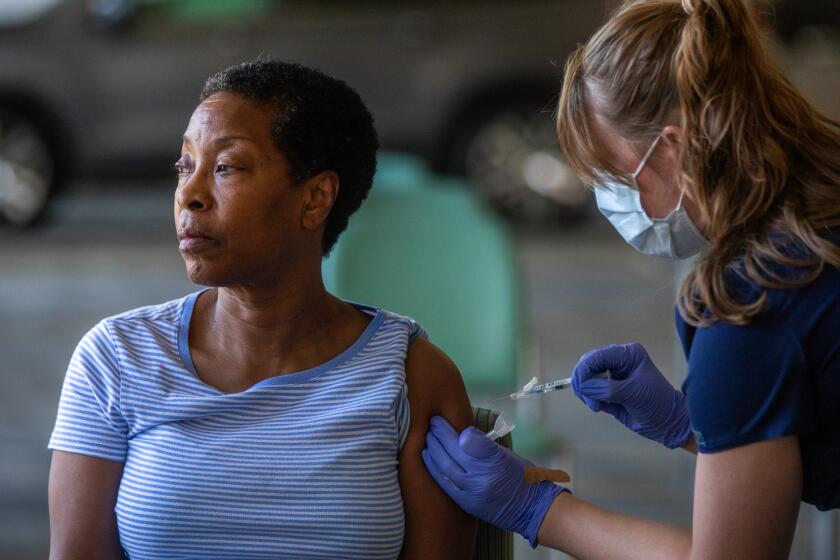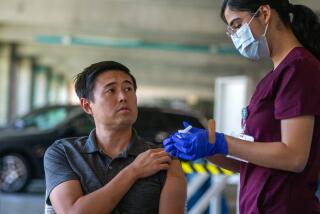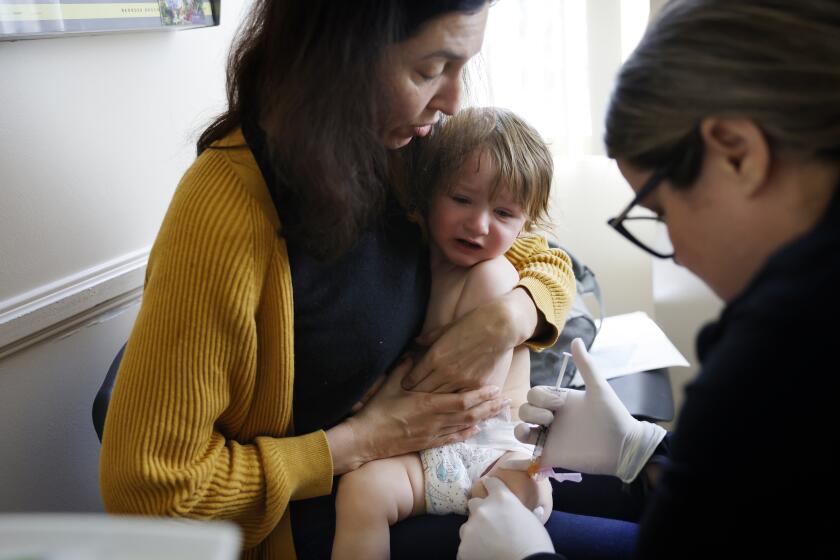A new coronavirus variant may be behind California’s COVID rise

Coronavirus transmission is once again spiking in California entering the winter holiday season — and a new subvariant may be partly to blame, officials say.
This latest subvariant, JN.1, is now estimated to account for roughly 44% of COVID-19 cases nationally, according to the latest data from the U.S. Centers for Disease Control and Prevention.
That share is twice as high as any other identified subvariant, and a startling rise from the prior estimate of 21% for the two-week period that ended Dec. 9.
“We’re also seeing an increasing share of infections caused by JN.1 in travelers, wastewater and most regions around the globe,” the CDC said in a statement. “JN.1’s continued growth suggests that the variant is either more transmissible or better at evading our immune systems than other circulating variants.”
COVID-19 and flu are rising across California, sparking new warnings from health officials to take precautions as the wider winter holiday season looms.
The World Health Organization this week classified JN.1 as a “variant of interest,” meaning it has potentially concerning characteristics — such as an ability to more easily infect individuals or avoid the protection afforded by vaccines and therapeutics.
Current vaccines, anti-COVID drugs and tests continue to work well against JN.1, the CDC said.
JN.1 is an offshoot of another Omicron subvariant, BA.2.86, which was unofficially nicknamed Pirola.
Pirola was already deemed worrisome because of its unusually high number of mutations, which might empower it to more easily infect those who haven’t received a recent COVID-19 vaccination. JN.1 has an additional mutation.
Only 5% of Californians have received the updated COVID-19 vaccine since it became more widely available earlier this month, and health officials say that’s not good enough.
Experts say all those mutations mean it’s likely that people who have been relying on older vaccinations received more than a year ago, or a previous infection earlier this year, may not be protected enough to avoid a new run-in with the coronavirus this winter.
“It is possible that at least part of the local increase in transmission is driven by new COVID-19 strains gaining dominance in Los Angeles County, including JN.1,” the county Department of Public Health said in a statement.
Doctors say the rise of JN.1 is another reason why people — especially those who are older — should get the latest COVID-19 vaccination that became available in September.
Coronavirus transmission and COVID-19 hospitalizations, though undoubtedly on the rise, aren’t at the levels seen at this same time last year.
But the increase has been sharp. For the week ending Dec. 16, there were 2,924 new coronavirus-positive hospital admissions in California, up nearly 50% from a month earlier.
And it’s not just COVID-19. Clinics in Southern California report being busy with other viral illnesses, too — namely flu and respiratory syncytial virus, or RSV.
“Definitely, we’re seeing more people that are coming through the door, especially the younger and the older,” said Dr. Daisy Dodd, an infectious disease specialist with Kaiser Permanente Orange County. People with underlying medical issues, such as diabetes and asthma, she added, are “much more symptomatic.”
The San Francisco Bay Area fared better during the COVID-19 pandemic than many other populated areas thanks in part to early stay-at-home orders, mask mandates and high uptake of vaccines, experts suggest.
In L.A. County, about 18% of specimens tested at sentinel labs are coming back positive for flu, as are 12% of specimens tested for RSV and 11% tested for the coronavirus. The test positive rates of flu and the coronavirus are continuing to grow, while the rate for RSV has plateaued at a high level.
Coronavirus levels recorded in L.A. County’s wastewater have doubled over the last month. For the week ending Dec. 9, the most recent data available, viral levels in sewage were at 39% of the peak seen last winter, the most recent major spike for the region.
But the increase in infections, to this point, has not translated into a surge of people needing intensive care, Dodd said.
At UC San Francisco, there are now 27 coronavirus-positive patients who are currently hospitalized, up from around 20 a few weeks ago. Earlier in November, that census was in the 10s, said Dr. Peter Chin-Hong, an infectious disease specialist there.
“That is probably fueled by this new variant, JN.1,” Chin-Hong said. “It’s not that the variant causes people to be sicker. It’s just that if a lot of people are infected, a proportion of them will go to the hospital. And the more people that get infected, that number is higher.”
Notably, COVID-19, flu and RSV seem to be all “colliding this year,” Chin-Hong said. “Last year, RSV would have gone down by now.”
Amid controversies over stay-at-home and masking orders, a lasting difference between Govs. Gavin Newsom and Ron DeSantis’ approach may end up being rhetoric on vaccine safety.
Other factors in the spread of COVID-19, which have been seen consistently this time of year since the pandemic began, are holiday travel and gatherings indoors. And in the first holiday season since the end of COVID’s emergency phase, people are perhaps not being as cautious as they once were in terms of testing or staying at home if they are sick.
Dr. Rafael Montalvo — chair of the urgent care department for the Facey Medical Group, which oversees clinics in Burbank, Mission Hills and Valencia — said some patients who are sick have been fairly nonchalant about their illness and are eager to work or remain out and about. Healthcare workers, he said, take care to try to convince patients to stay home when they’re ill.
“They’re actually pretty surprised when they [found out they’ve] come down with COVID,” Montalvo said. Unlike before, when people might have known where they picked up the coronavirus, “now, they’re not aware of any direct exposures.”
For the week ending Dec. 16, there were an average of 601 coronavirus-positive people in L.A. County’s hospitals, up about 66% from the prior month.
Some San Francisco Bay Area counties are reinstituting mask requirements in healthcare settings to coincide with arrival of the annual respiratory illness season.
The burden COVID is posing on L.A. County’s health system is still relatively low, however. For the week that ended Dec. 9, L.A. County was reporting 6.5 new coronavirus-positive hospital admissions for every 100,000 residents, which is considered a low level as defined by the CDC.
Still, there may be some warning signs. There were 24 new COVID outbreaks in skilled nursing facilities for the week that ended Tuesday, which represents a medium level of concern in the county’s established rubric. And for the week that ended Sunday, 5% of emergency department encounters in L.A. County were classified as related to the coronavirus, also enough to warrant a medium level of concern.
In Santa Clara County, Northern California’s most populous, coronavirus levels in the San Jose area’s sewage are at 62% of last winter’s peak.
Hospital conditions are worse elsewhere. Fresno County, which like the wider Central Valley has been particularly hard hit throughout the pandemic, said its hospitals are reporting “severely impacted conditions ... due to a historic number of admitted patients and people accessing the emergency department with non-urgent medical problems.”
Fresno County’s hospitals are operating at least 20% to 40% over capacity, and “are holding admitted patients in their emergency department for up to four days and are using conference rooms and non-patient areas to hold patients,” the local Department of Public Health said in a statement. Emergency room waiting times are now routinely exceeding 10 hours for some patients.
“We need everyone’s help to slow down the number of people using the emergency room for non-emergency medical issues,” Dan Lynch, the county’s emergency medical services director, said in a statement.
The Centers for Disease Control and Prevention says October is the right time to get vaccinated, before COVID circulation really ramps up.
The CDC recommends that virtually everyone age 6 months and older get a fresh COVID-19 and flu vaccination this winter. RSV vaccinations are also available for babies, those age 60 and older, and those who are pregnant.
Uptake of the most recent COVID-19 vaccination has been lackluster, however. Across California as of Nov. 30, 27% of seniors age 65 and up have received the latest shot. That rate is 21% in L.A. County, 25% in Orange County, and 27% in San Diego and Ventura counties; but less than 20% in the Inland Empire.
In the San Francisco Bay Area’s most populous counties, around 40% of seniors have received the latest COVID-19 vaccination.
As of Dec. 9, just 42% of adults nationwide had received a flu shot, 18% had received an updated COVID-19 vaccine, and 17% of those age 60 and up had received an RSV vaccine, according to reports published this week by the CDC. Notably, just one in three nursing home residents were up to date with their COVID-19 vaccinations.
“Many adults who had not received the vaccines reported being open to vaccination,” one of the reports said.
U.S. health officials are urging almost everyone to get both an updated COVID-19 shot and flu vaccine. An RSV shot is advised for older adults and women in late pregnancy as well.
The public health risk posed by JN.1 is similar to other subvariants in the sprawling Omicron family, the first version of which emerged a little more than two years ago. While these variants don’t pose the same threat as years prior, given a degree of immunity from past infections and immunizations, people who haven’t received a recent COVID-19 vaccination — particularly the new formula — are at greater risk.
“JN.1 [and other coronavirus variants] continue to cause disease and too many are falling ill, requiring hospitalizations or advanced clinical care, are dying, and developing long COVID,” Maria Van Kerkhove, WHO’s technical lead on COVID-19, wrote in a social media post. Nationally, about 1,000 coronavirus-infected people a week are dying.
Health officials have also urged people and healthcare providers to utilize anti-COVID drugs like Paxlovid when possible.
Some have been reluctant to take or prescribe the drug after reading last year of a purported “post-Paxlovid rebound,” in which COVID-19 symptoms reappear after having seemingly resolved. However, doctors have also long noted that COVID rebound can happen without taking Paxlovid. And a new study published this week by the CDC reaffirmed that COVID rebound can happen regardless of whether one takes anti-COVID drugs like Paxlovid or molnupiravir.
“Rebound should not deter providers from prescribing lifesaving antiviral treatments when indicated to prevent morbidity and mortality from COVID-19,” the report said.
Data increasingly suggest getting vaccinated reduces long COVID risk, a factor officials have cited in recommending most everyone get a reformulated vaccine this year.
CDC Director Dr. Mandy Cohen and others have urged people to take non-pharmaceutical precautions, such as wearing a mask in public settings, moving gatherings outdoors and improving ventilation, staying home when sick and avoiding people who are ill.
Other now-familiar measures include using hand sanitizer or regularly washing your hands, especially before eating, after sneezing or coughing, or while in public, the L.A. County Department of Public Health said.
“Consider talking with friends and family so they know to be cautious about gathering if they show signs of infection,” such as having a sore throat or a fever, the agency said. “Event hosts may want to consider asking their guests to test for COVID-19 before celebrations, especially if older or immunocompromised people will be present.”
California continues to require most insurers to reimburse covered people for the costs of up to eight at-home COVID tests per month, although people may need to obtain the tests through an “in-network” provider for the tests to remain free.
People who test positive for the coronavirus should isolate for at least five days following onset of symptoms or their first positive test result, whichever came first. The day a person starts having symptoms or had their first positive test is considered Day Zero, and the earliest a patient can exit isolation is by the end of Day 5.
The Biden administration is providing $600 million for new at-home COVID-19 tests and is restarting a website for Americans to order four free tests per household.
According to the L.A. County Department of Public Health, infected people can end isolation after Day 5 if they have been fever free for 24 hours without using fever-reducing medications, and don’t have any other symptoms, or their symptoms are mild and improving.
The agency strongly recommends people get a negative rapid test result before ending isolation between Days 6 and 10. Isolation can generally end after Day 10 without needing a negative test result, unless you still have a fever.
Infected people are encouraged to wear a mask around others for a full 10 day-period following onset of symptoms or their first positive test. But the agency says that people who meet the criteria to end isolation after Day 5 can stop wearing a mask, too, if they have two consecutive negative coronavirus test results taken at least one day apart.
More to Read
Start your day right
Sign up for Essential California for news, features and recommendations from the L.A. Times and beyond in your inbox six days a week.
You may occasionally receive promotional content from the Los Angeles Times.















